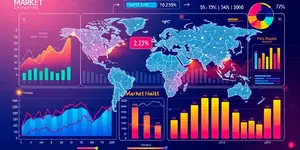
In an era of constant upheaval, decision-makers need more than intuition—they need a dynamic system to navigate uncertainty. The “Risk Radar” methodology was born from military and meteorological practices, now reimagined to drive business resilience and innovation. By synthesizing proprietary and public data, organizations can turn potential disasters into competitive advantages and emerging trends into strategic wins.
When markets shift, enterprises equipped with an adaptive radar framework gain clarity amid chaos. This article explores the anatomy of a Risk Radar, analyses current market risks, profiles essential tools, and shows how to transform threats into opportunities.
At its core, a Risk Radar is both mindset and mechanism. It involves constant data ingestion, intelligent analysis, and clear visualization. Modern platforms leverage machine learning for continuous monitoring, flagging anomalies in real time. Rather than periodic assessments, this approach fosters an always-on vigilance that scales across functions—from supply chains to product launches.
True mastery of the radar requires integrating qualitative insights with quantitative rigor. It pairs expert judgment and scenario planning with high-frequency signals, creating a holistic view of market dynamics and operational threats. The result is a living map of potential hazards and growth vectors.
Today’s risk environment demands comprehensive awareness. Organizations face a complex web of challenges spanning economic, technological, and environmental domains. Understanding these core vectors is the first step toward building an effective Risk Radar.
Building a Risk Radar starts with selecting and combining proven methodologies. Below is a concise overview of key tools and their applications across industries:
Operational risk is an ever-present reality. A structured process ensures threats are identified early and mitigated effectively. Core steps include:
When each phase is executed diligently, organizations benefit from systematic, technology-enabled risk tracking and sustained business continuity.
A powerful Risk Radar does more than defend—it uncovers new avenues for growth. By mapping vulnerabilities, leaders also reveal gaps where innovative solutions can flourish. This dual lens transforms potential losses into value creation as much as avoidance.
Collaborative stakeholder inclusion improves insights by incorporating diverse perspectives. Cross-functional teams spot unexpected synergies: a supply chain vulnerability might hint at a demand shift, while a regulatory threat could spawn a compliance-as-a-service offering.
Leading organizations have already harnessed Risk Radars to sharpen their competitive edge. In meteorology, advanced radar with cloud analytics has boosted forecast reliability by 35%, enabling proactive resource allocation. Financial institutions now embed scenario analysis into every strategic decision, satisfying regulators and safeguarding capital.
Meanwhile, cybersecurity firms deploy AI-driven threat detection that preempts sophisticated phishing and ransomware attacks. These success stories underscore the transformative power of a dynamic, data-rich radar approach.
As we look ahead, three forces will redefine risk sensing and response:
The boundary between threat and opportunity will continue to blur. Organizations that embrace a living Risk Radar—anchored in both technology and human insight—will not only survive but thrive.
In a world where uncertainty is the only certainty, your Risk Radar becomes the beacon guiding every strategic move. By adopting these frameworks and tools, you’re not just protecting your enterprise; you’re unlocking the next frontier of innovation and growth.
References













